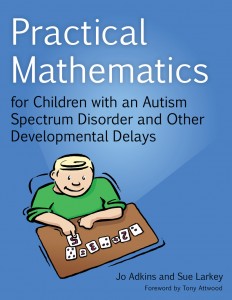Jo Adkins and Sue Larkey authors of ‘Practical Mathematics for Children with an Autism Spectrum Disorder and Other Developmental Delays’ (2013) explain their successful three step approach to making maths fun f or young learners.
or young learners.
It is a myth that all children with an Autism Spectrum Disorder (ASD) are good at mathematics. Mathematics is a skill that needs to be taught just like reading, spelling and any other skill. Although some children with an ASD are great at mathematics and often have a special interest in numbers, this is not enough. Many have rote learnt mathematics skills and have gaps in understanding key mathematical concepts. Our mathematics resource seeks to fill those gaps by engaging children in simple and enjoyable maths activities that can be completed at home with parents or in school.
Practical Mathematics has been designed to provide a sequential order of learning because like many other skills, mathematics cannot be taught fully until pre-requisite skills have been taught and achieved. Children with an ASD learn best through repetition and our programme provides lots of fun activities that children will want to do ‘over and over again!
Each section of the book is divided into three simple steps to ensure the child has consolidated each skill and can generalise the mathematics concepts in everyday situations.
Step 1: Where to start – Direct Teaching
The first step in teaching mathematics is using direct teaching. This involves one on one instructional teaching with an adult and child. Generally, this work is done at a table or on the floor – wherever the child can sit for a length of time and focus with minimal distraction. As your child’s attention to task and concentration span develops move to other environments.
Direct Teaching tasks can include matching card games, sorting colours, number lines and photo sequencing.
Step 2: Creating Opportunities to Practice
The second step in teaching mathematics is to create opportunities to practice those skills being taught in direct teaching. This involves creating opportunities to use the skills learnt in step 1 of a particular skill – whether these be engineered situations, or incidental teaching seizing the opportunity, where possible, when events occur during the child’s day.
Engineered Situations is where you deliberately set-up situations to teach; e.g. when dressing give your child only one sock so they need to request two or more; only give one of their favourite foods and get them to request a specific number more; or when watching a DVD, if you know they want a specific scene, get them to tell you which number.
Incidental teaching is where you follow your child’s lead; responding as situations occur during the day. For example, count food as you give to the child – “one, two, three shape biscuits”; verbalise activities – “Mummy wants three biscuits”; and general observations – when pushing a floor button in lift say “I want five”.
There are lots of situations during your everyday when you can count ‘how many’, ‘how long to wait’, ‘match shapes/colours’ or point out ‘what is different’. These are all very important mathematics concepts and the more you incorporate in everyday situations the quicker the child will learn and generalise.
Use Activity Based Instruction to learn mathematics skills across a number of activities – in different environments, with different people. In the book we give many examples of activity based instruction where you can teach mathematics skills through lots of different everyday activities such as Schedules, Music, Eating Times, Bath Time, etc. The key to knowing a child has learnt a concept is when they spontaneously use the concept or point it out to you, “Look a triangle” or ask for “three chips”.
Step 3: Assessing and Moving On
On-going assessments will help you identify any areas where the child may be struggling and some ideas on what to do to enhance skills and when to move on to next steps.
***
Practical Mathematics is designed as a starting point for introducing key mathematical concepts to young children. The programme is suitable for children from 2-8 years but also works well as a resource for older children who need to re-visit mathematical concepts in order to boost their understanding. Once the child has learnt the early mathematics concepts in this book, they should be able to access the normal school curriculum and preschool programmes – although this may be at varying levels.
Practical Mathematics for Children with an Autism Spectrum Disorder and Other Developmental Delays by Jo Adkins and Sue Larkey (2013) is published by Jessica Kingsley Publishers.